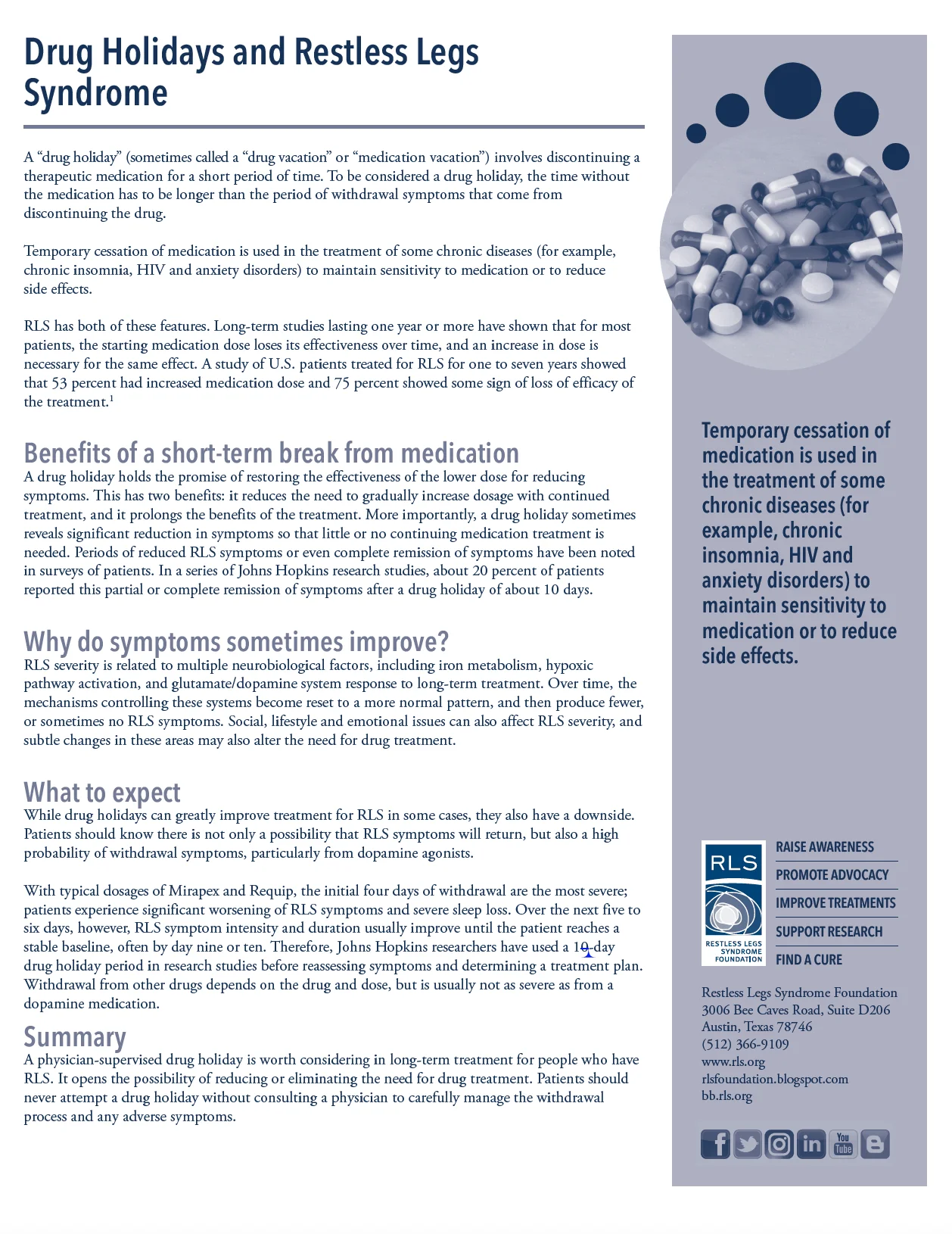Treatment and Medication for Restless Legs Syndrome.


Treatment and Medication for Restless Legs Syndrome.
Treatment for Restless Legs Syndrome.
Avoid food or substances that may causeor aggravate RLS symptoms. These include caffeine, alcohol or nicotine, oftenantihistamines and painkillers combined with antihistamines.
The sufferer cantry eliminating foods containing sugar and or gluten as these may beaggravating factors. A low fat diet is often recommended, but it is importantto include essential fatty acids such as Omega 3s, obtained from oily fish andfor vegetarians seeds and nuts. Omega 6s and Omega 9’s are obtained from seedand Olive oils. A balance of Omega 3s, 6s and 9s is highly recommended.
Indeed there are a number of naturalways to relieve this condition. For example increasing intake of foodscontaining B vitamins, folate and iron is to be recommended. This means eatingmore wholegrains, nuts, green leafy vegetables, citrus fruits and legumes suchas dried peas and beans. Non vegetarianscan increase intake of red meat, fish and poultry. Vegetarian sources of ironinclude green vegetables such as leafy greens and parsley (long favoured byFrench women) and dark red fruits and vegetables, the most concentrated being darkred dried apricots.
Someindividuals may benefit from the use of the highly sedative herb Valerian, andthere are several studies to support this. Other natural sedative herbs includeHops, Skullcap and Passionflower. These have been used for centuries withoutnegative side effects. Sufferers can add a teaspoonful of a blend of equalparts of these herbs to one cup of warm water and steep for 15 minutes. Thenthe tea must be strained and drunk before bed. However, most herbs these daysare available as a tincture, or in tablet or capsule form and vegetariancapsules without gelatine are available. Another beneficial herb that may helpRLS is St. John’s Wort traditionally used for naturally treating nervousnessand depression.
Yoga andmeditation as well as relaxation techniques can also be used to control RLS. Anumber of exercises are recommended as below.
Medication for Restless Legs Syndrome.
Drugtreatment to relieve symptoms and control RLS is recommended only in caseswhere the sufferer is having attacks at least three times a week. It isimportant to realise that drugs do not in any way cure the condition and shouldbe used only as a last resort.
The currenttreatment for severe or secondary (idiopathic or uraemic) RLS is Levodopa whichis a dopaminergic drug. In trials investigating the effectiveness of this druga single dose of 50 to 250 mg was administered 1 hour before bed. Results werehighly encouraging as patients reported better sleep and fewer periodic limbmovements (PLMS). The drug remains effective for at least two years.
The drugworks well given in regular release formulations and its effects seem to lastfor about four hours. Also given to the patient are sustained releaseformulations but for greatest effectiveness these do have to be administeredalongside the regular release doses, as sustained relief preparations, whengiven alone, tend to be insufficient. This is because Levodopa does not settleenough in the patient’s plasma before he or she is asleep. Patients who havedaytime symptoms of paraesthesias and restlessness do need more medication inthe day. Side effects are few and the drug is well tolerated on the whole withfew Parkinsonian symptoms. Formulation and timing of doses can be altered totreat different patterns and variations of symptoms.
Other drugswhich treat RLS are dopamine agonists – these include Bromocriptine ( adopamine D2receptoragonist) and pergolide (a combined D1 and D2 agonist) Low dosages that can be gradually increase are advised.Pramipexole is a new non-ergot dopamine agonist and is effective in improvingRLS symptoms. All these dopamine agonists cannot be administered in the sameway as Levodopa i.e. as needed by the patient. However, Levodopa can becombined with these drugs.
A last resortin treating RLS and PLMS is use of opioids which are effective but carry riskof dependency. Opioids include oxycodone, dextropropoxyphene napthylate anddihydrocodeine – these are short acting compounds and highly potent which alsoincludes tilidine which can be used in combination with the opioid antagonistnaloxone. Other opoids useful in treating severe disease are methadone orlevorphanol tartrate or epidural morphine in extremely severe cases.
A usefulclass of drugs to use for severe RLS are the Benzodiazepines which were firstinvestigated for use in the last century. Diazepam itself is not at all usefulin RLS treatment. At present the most widely used of these is Clonazepam which induces bettersleep. Treatment starts at 0.5 mg daily, is gradually increased but can be ashigh as 4 mg. Also effective for improving sleep is Triazolam; although it doesnot reduce the number of PLMS occurrences it reduces related arousals.
A very lastresort is the use of anticonvulsants. Carbamazapine, at daily doses of 200 to400 mg reduces nightly RLS symptoms but not frequency of PLMS. These are lesseffective than opioids and dopaminergic drugs. Currently being researched isGabapentin, which is related to GABA, as it is thought to be particularly welltolerated.
Return From Treatment and Medication for Restless Legs Syndrome to Help for Restless Legs.
Recent Posts
How do I create an engaging and informative online quiz or assessment?
Creating an engaging and informative online quiz or assessment can be a powerful tool for… Read More
What are the most effective methods for managing and reducing work-related stress in the hospitality industry?
Work-related stress is a common issue in the hospitality industry, where employees often face long… Read More
How can I improve my assertiveness and communication skills in a leadership position?
In a leadership position, assertiveness and effective communication skills are crucial for success. Being able… Read More
What are the key elements of a successful employee recognition and rewards program?
Employee recognition and rewards programs play a crucial role in motivating and engaging employees, as… Read More
How do I effectively manage and respond to customer feedback and reviews?
Customer feedback and online reviews play a crucial role in shaping a company's reputation and… Read More
What are the best strategies for effective time management as a stay-at-home parent?
Effective time management is crucial for stay-at-home parents who juggle multiple responsibilities on a daily… Read More